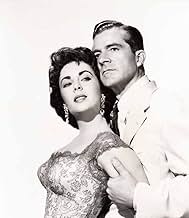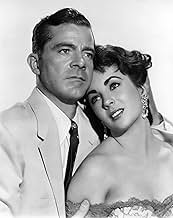IMDb RATING
6.3/10
2.8K
YOUR RATING
The young bride of a rich planter finds herself the only white woman at Elephant Walk tea plantation, British Ceylon.The young bride of a rich planter finds herself the only white woman at Elephant Walk tea plantation, British Ceylon.The young bride of a rich planter finds herself the only white woman at Elephant Walk tea plantation, British Ceylon.
My Lee Haulani
- Rayna
- (as Mylee Haulani)
Henry Carr
- Servant
- (uncredited)
Delmar Costello
- Native Patient
- (uncredited)
Jiva Raj De Alwis
- Servant
- (uncredited)
Charles Heard
- Planter
- (uncredited)
- Director
- Writers
- All cast & crew
- Production, box office & more at IMDbPro
Storyline
Did you know
- TriviaVivien Leigh was originally cast as Ruth. Her mental illness began affecting things during filming, and she was replaced by Dame Elizabeth Taylor. Many long shots and shots from behind are still of Leigh.
- GoofsDuring the first bicycle polo scene, there are four drink glasses on the server's tray when John Wiley takes one, followed by another rider who also grabs a glass, leaving just two on the tray. However the very next pass in which a rider goes for a glass the tray is full.
- Quotes
Ruth Wiley: Oh, what a beautiful view!
John Wiley: That's the elephant walk where the place got its name. Before the governor built here, the elephants used to come down that track for centuries to get to the water.
Ruth Wiley: They don't still try to come through do they?
John Wiley: Elephants always remember.
- ConnectionsFeatured in Edith Head: The Paramount Years (2002)
Featured review
ELEPHANT WALK may not be the acme of literature or of film, but it is great entertainment in the quasi-melodramatic mode. It is the story of love, both genuine and illicit, as well as overweening ambition, devotion, and the arrogance of personal tyranny. A previous reviewer, John Mankin, questions why the central focus of the film, the mansion called Elephant Walk, should have been built by the former owner, the "governor" the late Tom Wiley, right across the elephants' traditional path to the major source of water, the river. To miss this point is to essentially miss the point of the whole center of the film: the hubris of man. That his son, played by Peter Finch, should become enthralled by the super image and enigma of his revered father, is not unexpected, since the son was without a mother growing up in a foreign jungle with only his father and his father's rowdy 'boys' club' as his role models. The point of the father was that he was a self-made man who would tame nature to his liking, and that liking was not just a tea plantation upon the lands the elephants once dominated, but also that he would dominate even the large bull elephant that led the herd, and thus he would dominate his son and all around him, and so we join the tale after the elephants have been denied the crucial dry season access to their pathway to water. Who could know that this dry season would last so long and what the elephants would do in desperation to get water? This is the nexus of the film: what will animals do to get water; what will humans do to get power or love? Ceylon, today's Sri Lanka, is the huge island off the coast of India where the plantation is located and one quickly learns that it is the real scenery of the story, not just the expenses of Miss Taylor. Were it not for this exotic location (much of the film was shot in Ceylon), and the magnificent "bungalow" this would have been just another potboiler. One must recognize the atmosphere created here as integral to the time and place, as it illuminates the latter day wealth and power attained by the English immigrant 'conquerors' that were part and parcel of the British raj. It is only such wealth gained by the use of virtual slave labor that one could build so magnificent a residence of ebony, teak, and marble. Not to be overlooked are the wonderfully carved Jalees (grille work window and doorway borders) evidently specified by art directors J. McMillan Johnson and Hal Pereira and obviously made by the cheaper labor on the island. Such craftsmanship reveals the careful attention to detail that these men sought.
For those immune to the blandishments of time, place, and architecture, there is always the allure of Miss Taylor, as she marries a man she doesn't really know and is tacitly wooed by a another man, against the background described, and under the overarching tyranny of the legacy of a man deceased. As I said, it is not great literature nor even great film, but it is great spectacle long before that term was debased by the special effects extravaganzas of today.
This is one of those films made to be seen on the giant screen of an outdoor drive-in, not on the home TV, so arrange the largest screen to see it on to fully appreciate its fine camera-work and scope.
For those immune to the blandishments of time, place, and architecture, there is always the allure of Miss Taylor, as she marries a man she doesn't really know and is tacitly wooed by a another man, against the background described, and under the overarching tyranny of the legacy of a man deceased. As I said, it is not great literature nor even great film, but it is great spectacle long before that term was debased by the special effects extravaganzas of today.
This is one of those films made to be seen on the giant screen of an outdoor drive-in, not on the home TV, so arrange the largest screen to see it on to fully appreciate its fine camera-work and scope.
- How long is Elephant Walk?Powered by Alexa
Details
Box office
- Budget
- $3,000,000 (estimated)
- Gross worldwide
- $143
- Runtime1 hour 43 minutes
- Color
- Aspect ratio
- 1.37 : 1
Contribute to this page
Suggest an edit or add missing content
































